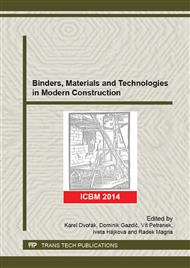[1]
C. Shi, P. V. Krivenko, D. Roy, Alkali-Activated Cements and Concretes, Taylor & Francis, Oxon, UK (2006).
DOI: 10.4324/9780203390672
Google Scholar
[2]
C. Shi, R. L. Day, Factors affecting early hydration characteristics of alkali-slag cements, Cem. Concr. Res. 26 (1996), 439-448.
DOI: 10.1016/s0008-8846(96)85031-9
Google Scholar
[3]
K. Byfors, G. Klingstedt, V. Lehtonen, H. Pyy, L. Romben, Durability of Concrete Made with Alkali Activated Slag. ACI SP Proceedings 114 (1989), 1429-1468.
Google Scholar
[4]
T. Bakharev, J.G. Sanjayan, Y. -B. Cheng, Resistance of alkali-activated slag concrete to acid attack, Cem. Concr. Res. 33 (2003), 1607-1611.
DOI: 10.1016/s0008-8846(03)00125-x
Google Scholar
[5]
M. Guerrieri, J.G. Sanjayan, F. Collins, Residual strength properties of sodium silicate alkali activated slag paste exposed to elevated temperatures, Mater. Struct. 43 (2010), 765-773.
DOI: 10.1617/s11527-009-9546-3
Google Scholar
[6]
A.M. Rashad, Y. Bai, P.A.M. Basheer, N.C. Collier, N.B. MILESTONE, Chemical and mechanical stability of sodium sulfate activated slag after exposure to elevated temperature. Cem. Concr. Res. 32 (2012), 333-343.
DOI: 10.1016/j.cemconres.2011.10.007
Google Scholar
[7]
P. Rovnaník, P. Bayer, P. Rovnaníková, Characterization of alkali activated slag paste after exposure to high temperatures. Const. Build. Mat. 47 (2013), 1479-1487.
DOI: 10.1016/j.conbuildmat.2013.06.070
Google Scholar
[8]
M. A. Cincotto, A. A. Melo, W. L. Repette, Effect of different activators type and dosages and relation with autogenous shrinkage of activated blast furnace slag cement, in: G. Grieve, G. Owens (eds. ), Proceedings of the 11th International Congress on the Chemistry of Cement, Durban, South Africa, 2003, pp.1878-1888.
DOI: 10.1016/j.cemconcomp.2010.01.004
Google Scholar
[9]
M. T. Liang, P. J. Su, Detection of Corrosion Damage of Rebar in Concrete Using Impact-Echo Method, Cement and Concrete Research 31 (2001) 1427–1436.
DOI: 10.1016/s0008-8846(01)00569-5
Google Scholar
[10]
J. Blitz, G. Simpson, Ultrasonic Methods of Non-Destructive Testing, Springer-Verlag, New York, LLC, (1991).
Google Scholar


